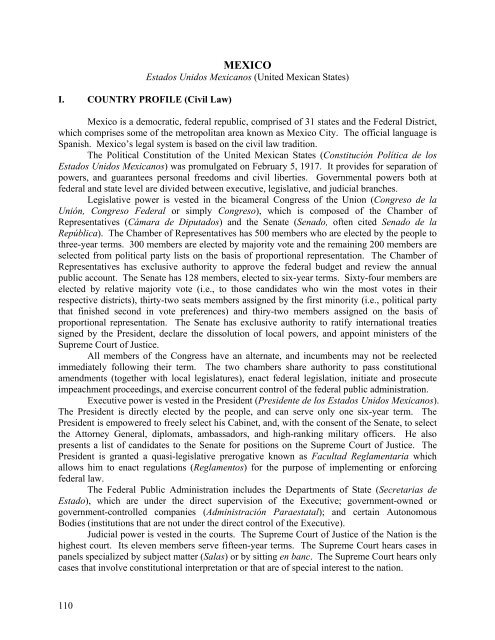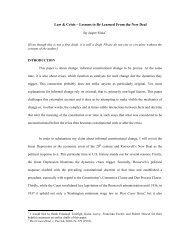Guide to Foreign and International Legal Citations - New York ...
Guide to Foreign and International Legal Citations - New York ...
Guide to Foreign and International Legal Citations - New York ...
Create successful ePaper yourself
Turn your PDF publications into a flip-book with our unique Google optimized e-Paper software.
110<br />
MEXICO<br />
Estados Unidos Mexicanos (United Mexican States)<br />
I. COUNTRY PROFILE (Civil Law)<br />
Mexico is a democratic, federal republic, comprised of 31 states <strong>and</strong> the Federal District,<br />
which comprises some of the metropolitan area known as Mexico City. The official language is<br />
Spanish. Mexico’s legal system is based on the civil law tradition.<br />
The Political Constitution of the United Mexican States (Constitución Política de los<br />
Estados Unidos Mexicanos) was promulgated on February 5, 1917. It provides for separation of<br />
powers, <strong>and</strong> guarantees personal freedoms <strong>and</strong> civil liberties. Governmental powers both at<br />
federal <strong>and</strong> state level are divided between executive, legislative, <strong>and</strong> judicial branches.<br />
Legislative power is vested in the bicameral Congress of the Union (Congreso de la<br />
Unión, Congreso Federal or simply Congreso), which is composed of the Chamber of<br />
Representatives (Cámara de Diputados) <strong>and</strong> the Senate (Senado, often cited Senado de la<br />
República). The Chamber of Representatives has 500 members who are elected by the people <strong>to</strong><br />
three-year terms. 300 members are elected by majority vote <strong>and</strong> the remaining 200 members are<br />
selected from political party lists on the basis of proportional representation. The Chamber of<br />
Representatives has exclusive authority <strong>to</strong> approve the federal budget <strong>and</strong> review the annual<br />
public account. The Senate has 128 members, elected <strong>to</strong> six-year terms. Sixty-four members are<br />
elected by relative majority vote (i.e., <strong>to</strong> those c<strong>and</strong>idates who win the most votes in their<br />
respective districts), thirty-two seats members assigned by the first minority (i.e., political party<br />
that finished second in vote preferences) <strong>and</strong> thiry-two members assigned on the basis of<br />
proportional representation. The Senate has exclusive authority <strong>to</strong> ratify international treaties<br />
signed by the President, declare the dissolution of local powers, <strong>and</strong> appoint ministers of the<br />
Supreme Court of Justice.<br />
All members of the Congress have an alternate, <strong>and</strong> incumbents may not be reelected<br />
immediately following their term. The two chambers share authority <strong>to</strong> pass constitutional<br />
amendments (<strong>to</strong>gether with local legislatures), enact federal legislation, initiate <strong>and</strong> prosecute<br />
impeachment proceedings, <strong>and</strong> exercise concurrent control of the federal public administration.<br />
Executive power is vested in the President (Presidente de los Estados Unidos Mexicanos).<br />
The President is directly elected by the people, <strong>and</strong> can serve only one six-year term. The<br />
President is empowered <strong>to</strong> freely select his Cabinet, <strong>and</strong>, with the consent of the Senate, <strong>to</strong> select<br />
the At<strong>to</strong>rney General, diplomats, ambassadors, <strong>and</strong> high-ranking military officers. He also<br />
presents a list of c<strong>and</strong>idates <strong>to</strong> the Senate for positions on the Supreme Court of Justice. The<br />
President is granted a quasi-legislative prerogative known as Facultad Reglamentaria which<br />
allows him <strong>to</strong> enact regulations (Reglamen<strong>to</strong>s) for the purpose of implementing or enforcing<br />
federal law.<br />
The Federal Public Administration includes the Departments of State (Secretarias de<br />
Estado), which are under the direct supervision of the Executive; government-owned or<br />
government-controlled companies (Administración Paraestatal); <strong>and</strong> certain Au<strong>to</strong>nomous<br />
Bodies (institutions that are not under the direct control of the Executive).<br />
Judicial power is vested in the courts. The Supreme Court of Justice of the Nation is the<br />
highest court. Its eleven members serve fifteen-year terms. The Supreme Court hears cases in<br />
panels specialized by subject matter (Salas) or by sitting en banc. The Supreme Court hears only<br />
cases that involve constitutional interpretation or that are of special interest <strong>to</strong> the nation.
















